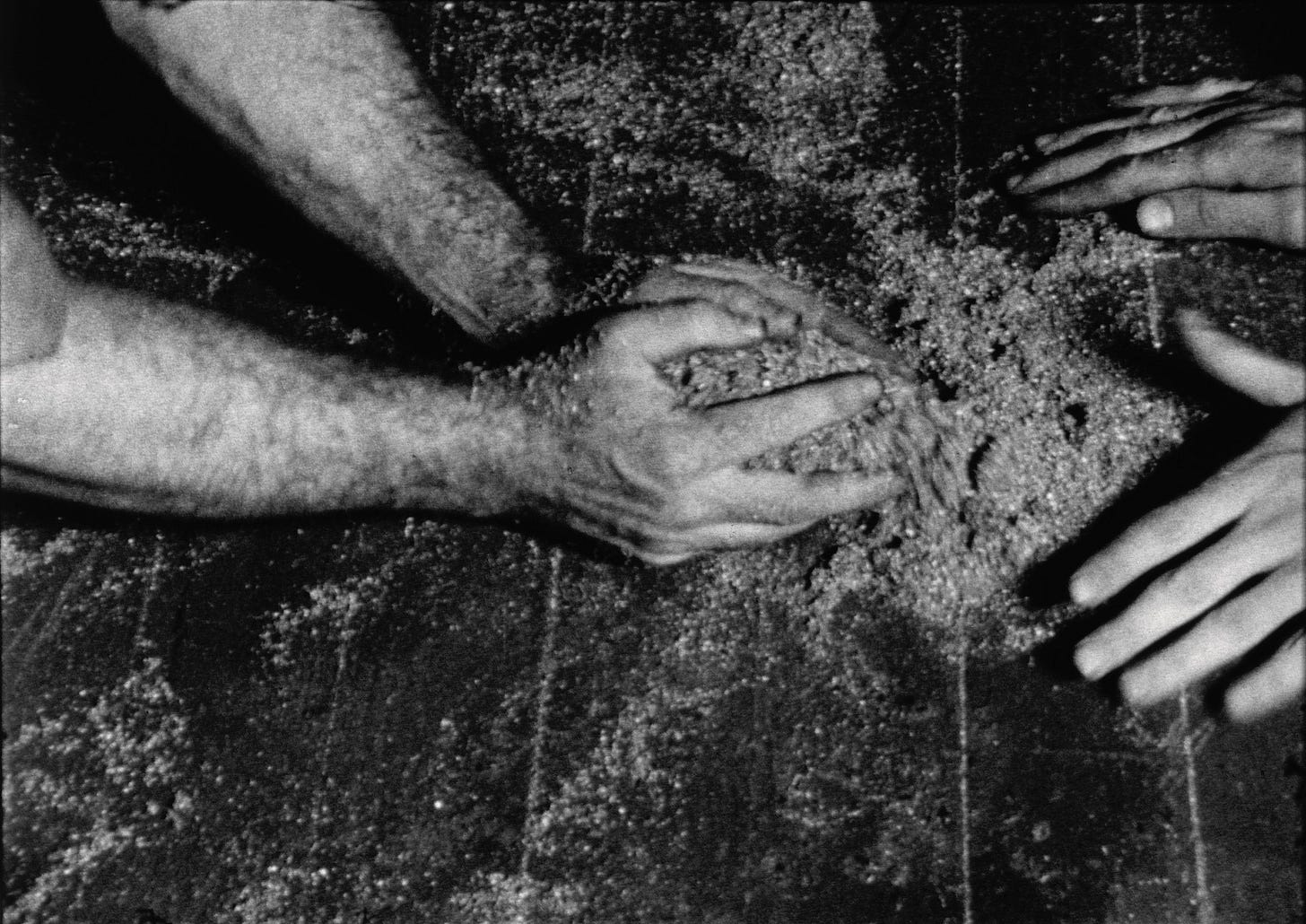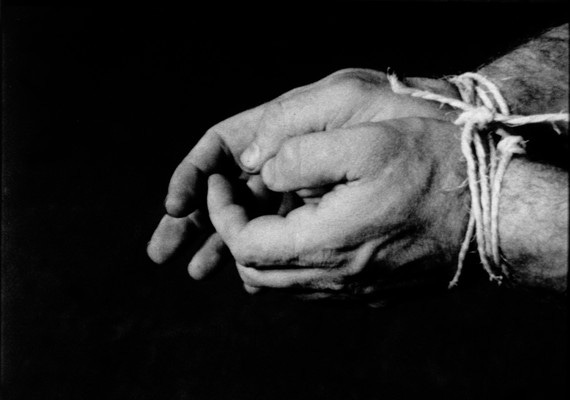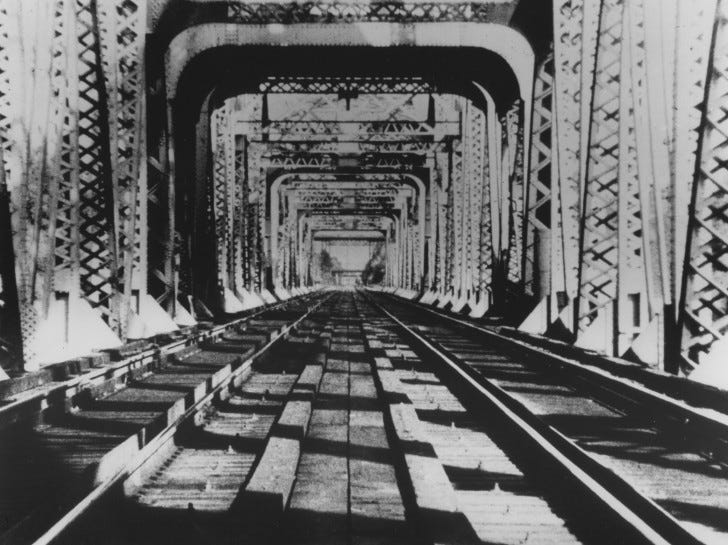I’ve not written one of these for a couple of weeks. Not out of any kind of specific cause or any more meandering lethargy. There’s been a cold that dug its heels in; performances; music; meals. Nor did I stop watching films. I suppose that ‘being permanently online’ requires its own holidays. But now, I am back baby.
— I’ve been thinking about hands. Bresson’s hands are like reflections, or wisps of fog that come and go – probing, anxiously; trembling. There are other more forceful hands – hands separated from bodies, hands as kinds of instruments (and pieces of instrumentation). Richard Serra’s hands — unlike Bresson’s, urbane, more physical — appeared only for a relatively brief order of time during his career as a sculptor and maker. Between 1968 and 1979 — just extending beyond a decade — he made a series of films in the tradition of the structural film, and in a way that purely artistic publications sometimes act surprised by (Carlos Valladares suggests that they probed an “uncharted phenomenological boundaries of the medium”). What are these hands doing?
— They are moving dirt around on a floor, grasping and cupping (the camera fixed, immobile — drinking in/up) (Hands Scraping, 1968). There are hands clutching (and failing to clutch) lumps of blur-edged lead (Hand Catching Lead, 1968). There are hands that are tied (a pair of them) (Hands Tied, 1968), and there is a hand holding a piece of lead (the same lead that — before — had ‘dropped’?) (Hand Lead Fulcrum, 1968). He would also make a (quite long) form of colour-field/flicker film in the lineage of Tony Conrad and Paul Sharits (Color Aid, 1970-71), but here I’m really most interested in his hand films, and — to a lesser extent — his Michael-Snow/Ernie Gehr-esque Frame (1969).
— The focus of these films is process, and the processual body. The tasks observed are cut-away/out from life, an action which could repeat indefinitely — without origin or failure. The structure of the film is determined artificially, and one in which the process becomes quickly defamiliarized. That’s because the action itself is slightly ordinary, even accidental — how we drop things, how we gather things or hold our hands together. These are physical acts that — in the daily ebb and flow of life — remain unconsidered, but which here Serra invests/injects with a phenomenological absurdity, and they become detached from their everyday-ness. With Frame (1969), Serra positions his camera to look out and down from a window (I believe it’s the window of his New York studio), and it has a not secretive association with a film like Wavelength by Michael Snow (1967). Serra himself actually said that Wavelength “was the most interesting thing that was happening [in film]”, and that it — and by extension his own films — had obtained a kind of uniquely American poetics.
— Frame (1969), 22 minutes in duration. The choice of this specific window seems arbitrary, and the film’s contents (qua Structural Film) are determined by that decision, but are also emergent — unpredictable. There is a wavering between authorial control and habitual randomness (for Serra could not control — though he could intuit — the events that would transpire beyond the window). It’s obviously not as flamboyant as Snow’s film, nor does it pierce and ironise the limits and boundaries of narrative cinema in the way that Snow managed.
— Tasks that unfold in quick ‘bursts’ of action, numbering a few minutes each. Hand Catching Lead (1968) reveals a brick wall (slightly out of focus) and an arm (presumably Serra’s own) which we can see almost up to the elbow. It functions with a certain stiffness. These film works (all in 16mm) were screened at Castelli Gallery not long after, where the viewer could watch the films play out in the space — screened simultaneously, without syncopation or timing. He was actually very hostile to the idea that these films had any meaningful connection to his sculptural practice, but this feels like a bit of a cope — because it’s undeniable for us, as a viewer, to think of Serra’s hand clutching at lead as not being somehow linked to his vast, industrial metallic sculptures. But they are also, decisively, films, and they are films which draw attention to themselves as films (how they isolate a particular space, how they end at a given point and begin at another — between the arbitrary and the authorial).
— He was clearly attempting to probe at the phenomenological, and at the thingness of things. With Railroad Turnbridge (1976) — a little later, also in 16mm — he shot a bridge, cementing it, questioning it; and forcing us to look at an (again) everyday structure in terms of its materiality and strangeness. Its hauntingness presumes a moment of arrival (a train, a la Lumiere) that never arrives. What does arrive is unexpected movement. It is a turnstile bridge, and so the linear vantage along the tracks (and through the metallic tunnel of the bridge’s supports and frame) begin to wobble and then flicker, and the landscape bends. It is really a continuation of his earlier Frame, albeit this time the ‘frame’ is not the wooden window but the square ‘vanishing point’ of the edge of the turnstile bridge, revealing a landscape of trees, a river bank, water, cranes, buildings, without ever showing us the mechanism that enables its pirouette-moving. He has again estranged this ‘everyday’ function, enobling it and revealing the kind of everyday poetry that lies latent within it. We are not given the whole, but rather a ‘part’ of the matrix of a process is extracted and presented before our eyes without context or commentary.
— How deeply Serra’s films shake hands with structural film (as a movement-within-a-movement) is debatable. Peter Gidal has written that the structural film “approaches emptiness”, and is without referential meaning (I always feel like they approach a kind of excess). They certainly ground and determine themselves by their own structure. Serra’s experiments are like the structuralists and also unlike them; emphasis placed on the viewing-perception of the film’s unfolding – a total object which folds into itself. This is certainly the argument Serra himself was making (that the film is not a reflection on his own practice, Etc). That he would later abandon film suggests that it really was a kind of reflection on his own practice — a study of the corporeal instrument of other-making. Or he simply grew bored of it, the process. He exhausted the grasp/the bind/the frame. He looked elsewhere. But you should watch them — their uncanny/eeriness.
If you liked this newsletter then please consider liking, sharing or subscribing. It’s lonely here.







